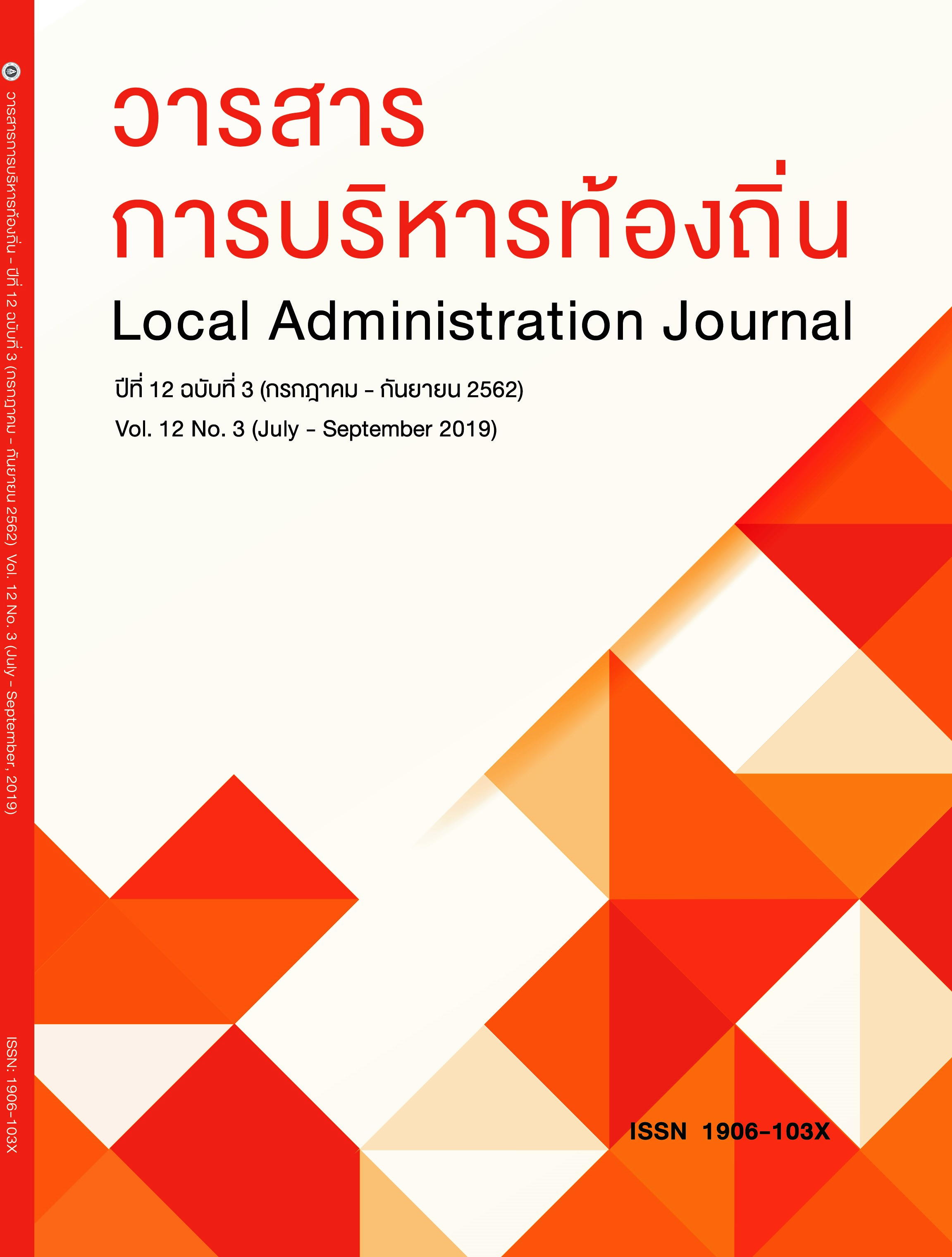Development of Community-based Tourism Based on the Grassroots Economy Concept
Keywords:
Community- based Tourism, Grassroots Economy, Strategic Planning on Community-based TourismAbstract
Community-based tourism is an important issue at the national and international levels. In addition, the community-based tourism situation has experienced an increase in growth rate. This trend makes public agencies and tourism network parties be aware of the concept of community-based tourism and mutually develop such tourism in Thailand to reach international standard which the development mainly focuses on local people to participate in tourism activities in their community. This article is intended to study community-based tourism issues and grassroots economy concept based on review of related literature and research. It aims to analyze relationships between community based tourism and grassroots economy in which tourism is a tool for sustainable community development through the principle of grassroots economy. This includes analyzing a strategic plan on sustainable community-based tourism to strengthen competency of human resource in the community. This is on the basis of their potential in community-based tourism management and self-reliance based on sufficiency. Also, it aims to add value of resources in tourist spots on the basis of local identity. Not only this, it focuses on the creation of happiness between local people and tourist. Importantly, residents in the community are encouraged and supported in terms of fair income distribution from community-based tourism. This helps reduce social inequality and truly promote sustainability in the community.
References
กระทรวงการท่องเที่ยวและกีฬา และองค์การบริหารการพัฒนาพื้นที่พิเศษเพื่อการท่องเที่ยวอย่างยั่งยืน(องค์การมหาชน). (2559). แผนยุทธศาสตร์การท่องเที่ยวโดยชุมชนอย่างยั่งยืน พ.ศ. 2559-2563. กรุงเทพฯ: กระทรวงการท่องเที่ยวและกีฬาและองค์การบริหารการพัฒนาพื้นที่พิเศษเพื่อการท่องเที่ยวอย่างยั่งยืน(องค์การมหาชน).
การท่องเที่ยวแห่งประเทศไทย. (2559). การท่องเที่ยวโดยชุมชนอย่างยั่งยืน. สืบค้นเมื่อ 3 พฤษภาคม 2562, จาก https://www.tatreviewmagazine.com/article/cbt-thailand/
กุลฑิกา สงวนพันธุ์ และอัชกรณ์ วงศ์ปรีดี. (2561). แนวทางการพัฒนาแบบจำลองสินค้าชุมชนเชิงวัฒนธรรมของประเทศไทย: กรณีศึกษาสินค้าชุมชนเชิงวัฒนธรรมใน 5 พื้นที่จังหวัด. วารสารการบริหารท้องถิ่น, 11(4), 102-130.
คณะกรรมการนโยบายการท่องเที่ยวแห่งชาติ. (2559). เกณฑ์การพัฒนาการท่องเที่ยวโดยชุมชนของประเทศไทย. กรุงเทพฯ: คณะกรรมการนโยบายการท่องเที่ยวแห่งชาติ.
คณะอนุกรรมการยุทธศาสตร์เศรษฐกิจฐานราก. (2559). คู่มือการพัฒนาระบบเศรษฐกิจฐานราก. กรุงเทพฯ: สถาบันพัฒนาองค์กรชุมชน(องค์การมหาชน).
ฐิติ ฐิติจำเริญพร และคณะ. (2559). รายงานวิจัยฉบับสมบูรณ์ โครงการวิจัยย่อยที่ 1 การศึกษาความต้องการของตลาดที่มีศักยภาพเรื่องการท่องเที่ยวโดยชุมชนในประเทศไทยและอาเซียน. กรุงเทพฯ: สำนักงานคณะกรรมการการวิจัยแห่งชาติ (วช.) และสำนักงานกองทุนสนับสนุนการวิจัย (สกว.).
พจนา สวนศรี. (2546). คู่มือการจัดการท่องเที่ยวโดยชุมชน. กรุงเทพฯ: โครงการท่องเที่ยวเพื่อชีวิตและธรรมชาติ.
สถาบันการท่องเที่ยวโดยชุมชน. (2556). การท่องเที่ยวโดยชุมชน. สืบค้นเมื่อ 12 พฤศจิกายน 2556, จาก https://cbt-i.org/cbt/
สำนักงานปลัดกระทรวงการท่องเที่ยวและกีฬา. (2560). รายงานภาวะเศรษฐกิจท่องเที่ยว. กรุงเทพฯ: สำนักงานปลัดกระทรวงการท่องเที่ยวและกีฬา.
สินธุ์ สโรบล. (2546). การท่องเที่ยวโดยชุมชน แนวคิดและประสบการณ์พื้นที่ภาคเหนือ. เชียงใหม่: วนิดา เพรส.
องค์การบริหารการพัฒนาพื้นที่พิเศษเพื่อการท่องเที่ยวอย่างยั่งยืน (องค์การมหาชน). (2559). รายงานการประชุมประชาพิจารณ์แผนยุทธศาสตร์การท่องเที่ยวโดยชุมชนอย่างยั่งยืน เรื่องการท่องเที่ยวโดยชุมชน: ประชารัฐกับการพัฒนาเศรษฐกิจฐานรากสู่ความอยู่ดีมีสุข. กรุงเทพฯ: องค์การบริหารการพัฒนาพื้นที่พิเศษเพื่อการท่องเที่ยวอย่างยั่งยืน (องค์การมหาชน).
Translated Thai References
Designated Areas for Sustainable Tourism Administration (Public Organization). (2016). Community based tourism: civil state and grassroots economy development to good quality of life. (Public Hearing Report). Bangkok: Designated Areas for Sustainable Tourism Administration (Public Organization). (In Thai)
Ministry of Tourism and Sports and Designated Areas for Sustainable Tourism Administration (Public Organization). (2016). Strategic plan on community-based tourism 2016-2020. Bangkok: Ministry of Tourism and Sports and Designated Areas for Sustainable Tourism Administration (Public Organization). (In Thai)
Ministry of Tourism and Sports. (2017). Tourism Economic Report. Bangkok: Ministry of Tourism and Sports. (In Thai)
Sanguanpan, K. & Wongpreedee, A. (2018). A Model for the Development of Culturally-Relevant Community Products in Thailand: A Case Study of Five Provinces. Local Administration Journal, 11(4), 102-130. (In Thai)
Sarobol, S. (2003). Community based tourism: concept and experience in Northern Thailand. Chiangmai: Wanida Press. (In Thai)
Suansi, P. (2003). Community based tourism management hand book. Bangkok: Responsible Ecological Social Tour – REST. (In Thai)
Subcommittee on Grassroots Economy Strategic Plan. (2016). Grassroots Economy Development Handbook. Bangkok: Community Organizations Development Institute. (In Thai)
The Committee on National Tourism Policies. (2016). Criteria for community based tourism development. Bangkok: The Committee on National Tourism Policies. (In Thai)
The Thailand Community Based Tourism Institute. (2013). Community based tourism. Retrieved November 12, 2013, from https://cbt-i.org/cbt/ (In Thai)
Thitichamroenphon, T. et al. (2016). A study of quality target marketing demand for community based tourism in Thailand and ASEAN. (Complete Research Report). Bangkok: National Research Council of Thailand and The Thailand Research Fund. (In Thai)
Tourism Authority of Thailand. (2016). Sustainability of community based tourism. Retrieved May 3, 2019, from https://www.tatreviewmagazine.com/article/cbt-thailand/. (In Thai)
Downloads
Published
How to Cite
Issue
Section
License
The copyright of all articles published in the Local Administration Journalis owned by the College of Local Administration, Khon Kaen University.


